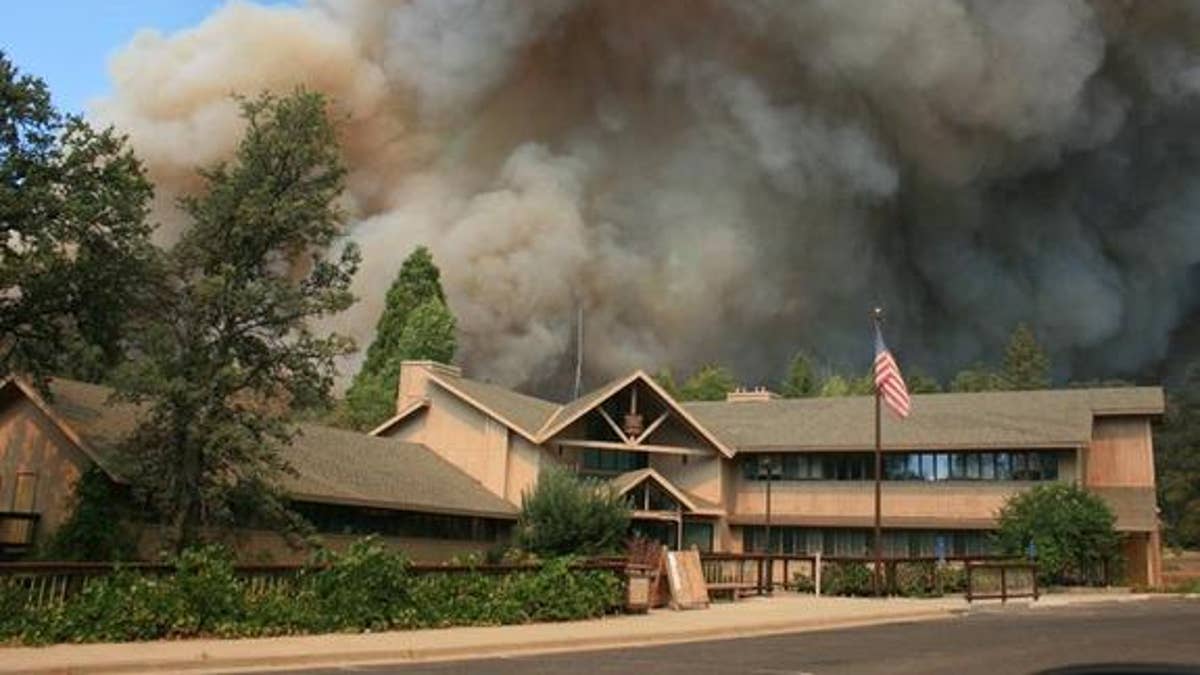
The Rim Fire approaches the Groveland Ranger Station in August 2013. (U.S. Forest Service)
One of the worst wildfires in California's history continues to burn in Yosemite National Park, where employees will be furloughed following the government failure to pass a budget.
The Rim Fire has burned more than 257,000 acres and is 92 percent contained. (Containment means the fire can still burn, but the flames are trapped within a perimeter, with little chance of escape.)
Very little is left of the extreme blaze, which consumed entire canyons. Now, a few hot spots char the ground in Yosemite National Park, where Park Service policy allows nonthreatening fires to burn themselves out, renewing the forest. "It's burning at very, very low intensity," said Michelle Carbonaro, fire information officer for the Rim Fire. "We suspect they're not calling it [as] out because there are some unsettled weather patterns coming that could stir up fire activity," Carbonaro told LiveScience.
But the shutdown could hamper efforts to mop up hot spots and stabilize scorched soils because it will mean firefighters and emergency response teams will be low on cash.
"It will be difficult for teams to purchase supplies and equipment," said Jerry Snyder, public affairs officer for the Stanislaus National Forest. "Permission can be granted, but there isn't a budget to purchase necessary materials beyond what they already have on hand."
- Junior genius: Winners of the 2013 Google Science Fair
- Partial gov’t shutdown will ground NASA almost entirely
- NASA’s new commercial supply ship reaches space station
- MIT, Harvard scientists accidentally create real-life lightsaber
- UN’s massive new climate report adds little explanation for ‘pause’ in warming
The shutdown will also be a financial blow for Yosemite National Park and private businesses nearby, which suffered severe economic losses this summer because of the fire. With the Rim Fire nearly out and major roads reopened, visitors were finally returning to Yosemite for camping and the park's fall foliage display. [Yosemite Aflame: Rim Fire in Photos]
The National Park Service must shutter hundreds of parks and historic sites and furlough thousands of nonessential employees on Tuesday, the start of fiscal year 2014, according to the Department of the Interior. Day trippers will be kicked out immediately and overnight visitors will be given 48 hours to leave.
For Yosemite National Park, the good news is the shutdown won't stop firefighters from battling the blaze. And in the Stanislaus National Forest, an emergency soil restoration team will continue its efforts to stabilize steep slopes before the winter rains arrive, Snyder said. Both the soil restoration team and firefighters are considered essential employees, he said.
The Forest Service's Burned Area Emergency Response Team the soil emergency restoration team has found moderate to severe soil damage in 37 percent of the entire burned area, which includes river watersheds that supply drinking water to San Francisco and many other California cities.
Only 287 firefighters (down from more than 4,500 in late August) continue to mop up hot spots and work on containing the Rim Fire. Started in Stanislaus National Forest on Aug. 17 by a hunter's illegal campfire, the Rim Fire is California's third-largest wildfire since the 1930s and the biggest ever in the Sierra Nevada mountains. The fire destroyed 11 homes and more than 2 million board-feet of timber in the national forest. (A board-foot is a measure of the volume of lumber, referring to a board that is 1 foot in length and width and 1 inch thick.)
"The fire is fully contained in the Stanislaus National Forest, but there are plenty of internal smokes that we are chasing down and trying to put out," Snyder told LiveScience.
Copyright 2013 LiveScience, a TechMediaNetwork company. All rights reserved. This material may not be published, broadcast, rewritten or redistributed.
